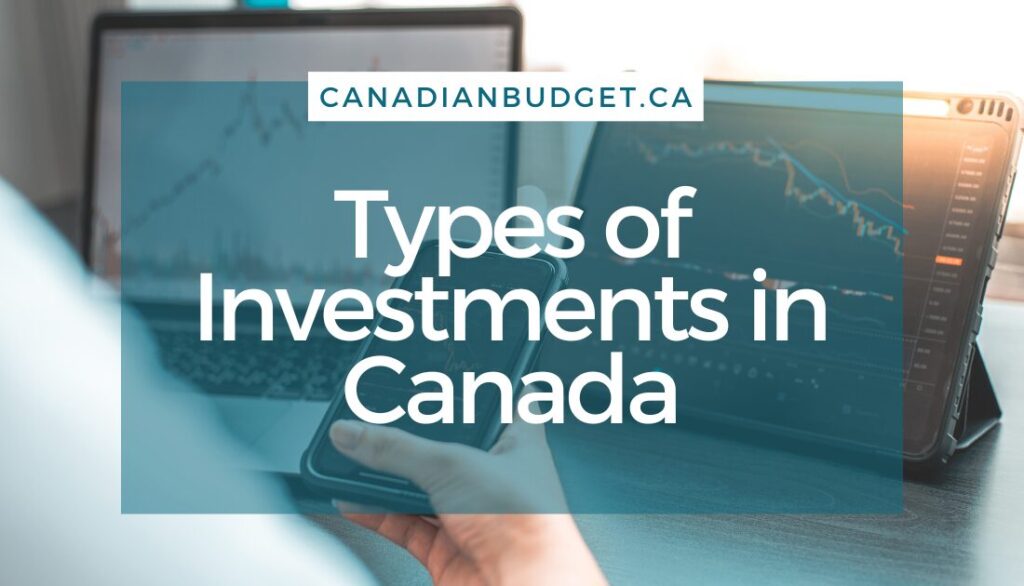There is a lot to understand about the different types of investments available in Canada. From the traditional options of stocks and bonds to the more alternative routes of real estate and cryptocurrency, we will explore a range of investment vehicles.
Discover each option’s potential risks and rewards and their role in your portfolio to help you reach your goals.
Whether you are a seasoned investor looking to diversify your portfolio or a beginner taking your first steps into the investment world, this guide is designed to empower you.
What are investments?
Table of Contents
ToggleThe term ‘investment vehicle’ is often used to describe an investing account or a type of investment. It refers to something that allows individuals or organizations to allocate their money with the expectation of generating a return or profit over time. By investing, you are putting your money to work to grow it. Various types of investments are available, each with its own set of risks and potential rewards.
A few key concepts to help beginner investors are diversification and the risk/return relationship.
Diversification plays a pivotal role in successful investing. By spreading your investments across various investment types (or asset classes), you can effectively reduce the overall risk in your portfolio. If one investment performs poorly, the others may offset the losses. Taking steps to diversify your portfolio helps you to take advantage of different market conditions and can increase your likelihood of achieving your financial goals.
Learning to understand the crucial relationship between risk and return is key in the world of investing. Generally, higher potential returns in investments also come with higher risks, but those returns are never guaranteed. It is necessary to assess your risk tolerance and investment goals before deciding on the types of investments to pursue. Let’s dive into some of the most commonly known investment options.
What are the various types of investments?
Cash and Cash Equivalents
The most liquid and typically safest investments are known as “Cash and cash equivalents. Under this broad heading, we find investments such as the literal cash in your account, High-Interest Savings ETFs, Money Market Funds, and GICs.
Equities
Equities, or stocks, also known as shares, represent ownership in a company. When you buy shares in a company (aka buy their stock), you become a shareholder of that company. You then have a claim on the company’s assets and earnings. Stocks trade on stock exchanges, like the New York Stock Exchange or Toronto Stock Exchange.
In order to buy shares on an exchange, investment account like a TFSA or RRSP at a brokerage.
Investing in individual stocks can be a way to benefit from the growth and success of specific companies. However, stock prices can be volatile and are subject to market fluctuations. So, although you may make money, you will probably also lose money. You must undertake thorough research and analysis before investing in individual stocks.
Bonds or Fixed Income Securities
Bonds are debt issued by governments, municipalities, or corporations. Buying a bond makes you a lender to the issuer who pays you regular interest payments as well as returning the principal amount at maturity. Bonds are less risky than stocks but also offer lower potential returns.
Government bonds are among the safest because the government backs them. Corporate bonds carry a higher risk level depending on the issuing company’s financial health. Provincial/State or local governments issue municipal bonds to fund public projects and are generally exempt from federal taxes.
Bonds can give you a steady income stream and cushion your portfolio during market downturns. They can also preserve capital and stabilize a diversified investment portfolio

Investment Funds
Another option is investing in mutual funds, Index funds or exchange-traded funds (ETFs). These funds accept money from multiple investors to invest in a diversified portfolio of stocks. Investors then gain exposure to a broad range of companies without having to select individual stocks themselves.
Mutual Funds
Mutual funds are investment options that people choose when they are looking for a diversified portfolio of stocks, bonds, or other assets. Mutual funds hire professional fund managers to actively manage them. The managers make investment decisions on behalf of the investors, such as what stocks are included, what percent of each stock or fund is represented in the mutual fund, when to change the allocation of stocks in the fund, and more.
Mutual funds provide investors exposure to a diversified portfolio without having to select individual investments themselves. This can be attractive for beginner investors or those who prefer to hand over their investing to an expert. Mutual funds come in various configurations, including equity, bond, balanced, and index funds. Because portfolio managers actively manage mutual funds, they tend to charge higher fees.
ETFs
ETFs are funds that contain many stocks yet can be purchased in a single transaction. You may buy shares from up to thousands of companies in one purchase. ETFs can be traded throughout the day as if they were stocks on the stock market. ETFs tend to have lower fees because of their passive management style.
Index Funds
Index funds aim to replicate, not beat, the performance of the market index they track by holding the same stocks in the same proportion (For instance, tracking an index like the S&P 500 or the TSX/S&P Composite). By doing so, the fund does not rely on a manager to pick the underlying assets. Therefore, this type of investment is referred to as being passively managed.
Unlike ETFs and stocks that trade throughout the day, orders to buy or sell are completed once a day at the end of the day after the market closes. Index funds also have more competitive fees because of their passive management style.
Alternative Investments
Real Estate
Real estate can be valuable to an investment portfolio as it provides long-term growth and diversification potential.
There are various ways to invest in real estate, including direct ownership, investing in real estate investment trusts (REITs), and real estate crowdfunding. Direct ownership involves purchasing properties outright or through taking on mortgages and renting them out to generate rental income. This option requires active management and may involve additional property maintenance and tenant management responsibilities.
Real Estate Investment Trusts (REIT)
REITs are organizations that own, operate or finance income-generating real estate. By investing in REITs, individuals can gain exposure to a diversified portfolio of properties without needing direct ownership. REITs trade on major stock exchanges, similar to stocks, and provide regular dividend payments to investors.
Real Estate Crowd Funding
Real estate crowdfunding platforms enable investors to contribute smaller amounts for real estate projects. These platforms connect investors with developers or property owners seeking project funding. Individuals can access real estate investments with lower capital requirements and potentially higher returns by investing in real estate crowdfunding.

Crypto Currency
Of the various types of investments out there, one of the highest risk and most volatile is Cryptocurrency, Most common and well known crypto currencies are Bitcoin and Ethereum, however there are many many more out there. Crypto is highly speculative and extremely high-risk. If you invest in crypto, a safe play is keeping it a tiny portion of your overall portfolio and never investing anything you can’t afford to lose in its entirety.
Where can I invest in stocks and other types of investments?
You need to open a brokerage account as your first step before you can put your money into almost any type of investment. A Brokerage facilitates the buying and selling of stocks and funds on the stock market for you. We have compiled a list of beginner-friendly investment platforms in Canada, but your bank may also provide a brokerage. Once you have opened your brokerage account, you need to decide what type of investment account you want to open.
Some Account types:
- TFSA – Tax Free Savings Account
- RRSP – Registered Retirement Savings Plan
- FHSA – First Home Savings Account
- RESP – Registered Education Savings Plan
- RDSP – Registered Disability Savings Plan
- RRIF – Registered Retirement Income Fund
Why is it important to diversify your investment portfolio
The age-old saying “Don’t put all your eggs in one basket” holds when investing. By spreading your investments across various types of investments, asset classes, regions, and industries, you can reduce the impact of any single element’s performance on your overall portfolio.
Diversification helps protect your investments from risks associated with a particular asset class or industry. Different investment types have different risk and return characteristics, and by diversifying, you can tap into the potential growth of multiple sectors. This minimizes your exposure to volatility and helps your portfolio weather market fluctuations.
There are other forms of diversification in addition to asset class diversification. For example, you can diversify by investing in different industries, company sizes, or geographic regions. By spreading your portfolio across a range of investments, you reduce the risk in a concentrated portfolio.
Diversifying the investments within your portfolio is the key to managing your risk and maximizing returns. It allows you to protect your investments from specific risks, take advantage of various investment opportunities, and minimize the impact of market fluctuations.
Understanding risk and return on investments
When it comes to investing, risk and return go hand in hand. Risk details the likelihood of you losing money in a particular investment. Different investment options have their own levels of risk, and it is essential to understand your own appetite for risk before making investment decisions. Investing mistakes from FOMO often happen because we jump in without due diligence and invest in something too risky for our comfort levels.
Assessing whether you are risk-averse or risk-tolerant can help you to match the right types of investments with your financial goals. You want to choose investments that provide you with growth and income at a rate that will help you reach your goals and a risk level that you can tolerate.
Understanding the relationship between risk and return for the investments you choose is crucial for making informed investment decisions. These various investment options come with varying levels of risk, and it is essential to know your risk tolerance and align it with your financial goals.
Conclusion: Choosing suitable investment options for your financial goals
We have explored different types of investments and their potential risks and rewards. Each investment option offers unique growth and income opportunities. Purchasing investments requires a brokerage account and an investment account like a TFSA or RRSP.
Diversifying the types of investments you choose across various investment types can help you manage risk and stay invested. Investing in different asset classes and across other elements like regions and sectors can protect your investments from specific risks and take advantage of opportunities.
Understanding your relationship with risk will help you determine which investments suit you and ensure you are comfortable with the level of risk involved. Remember, investing is a long-term endeavour, and it is essential to keep an eye on your performance and adjust your portfolio as your financial goals and market conditions change. Stay informed on market happenings, get educated, seek professional advice if needed, and always make educated decisions based on your circumstances.
About The Author
Jessica Morgan
Jessica Morgan is the founder and CEO of Canadianbudget.ca. She is passionate about personal finance and helping Canadians improve their financial literacy by providing more Canadian focused financial content. A millennial mom of one, she has a burning obsession with all things personal finance.
Jessica has a BA in East Asian Studies from York University and a Masters in Business Administration from Toronto Metropolitan University. She is a career public sector employee with a Hybrid Pension, and an advocate for Canadian women to improve their personal finance knowledge.

